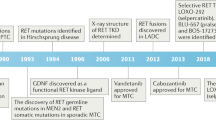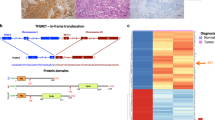Abstract
Multiple endocrine neoplasia type 2A (MEN 2A) and familial medullary thyroid carcinoma (FMTC) are two dominantly inherited disorders caused by germline mutations of the RET proto-oncogene. The RET gene codes for a receptor tyrosine kinase. The majority of MEN2A and FMTC mutations are clustered in the extra-cellular cysteine-rich domain and result in constitutive activation of the tyrosine kinase through the formation of disulfide-bonded RET homodimers. Recently, two novel point mutations have been identified in the germline of five distinct FMTC families. Both mutations occur within the catalytic domain of the RET kinase and lead to the substitution of either glutamic acid 768 or valine 804 by an aspartic acid and a leucine respectively. We have introduced each FMTC mutation in two RET isoforms: RET51 the long isoform (1114 aa) and RET9 the short isoform (1072 aa) which differ in the C-terminal region of the protein. The RET51 isoform carrying either E768D or V804L mutation was autophosphorylated, displayed a transforming activity upon expression in Rat1 fibroblasts and induced neuronal differentiation of PC12 cells. However, the transforming capacity of these RET51-FMTC mutants was found to be severalfold less potent compared to the same isoform carrying either the MEN2A mutation (C634R) or the MEN2B mutation (M918T). In contrast, RET9 containing mutations E768D or V804L was not autophosphorylated, exhibited a poor oncogenic potential in fibroblasts and did not promote neuritic outgrowth upon expression in PC12 cells. Overall, these findings demonstrate that mutations E768D and V804L are gain-of-function mutations that confer to the long RET isoform the capacity to exert a biological effect, although these mutations are more weakly activating than the MEN2A and MEN2B mutations. These results may provide a biochemical basis as to why the phenotypic consequences of these mutations are restricted to thyroid C-cells.
This is a preview of subscription content, access via your institution
Access options
Subscribe to this journal
Receive 50 print issues and online access
$259.00 per year
only $5.18 per issue
Buy this article
- Purchase on Springer Link
- Instant access to full article PDF
Prices may be subject to local taxes which are calculated during checkout
Similar content being viewed by others
Author information
Authors and Affiliations
Rights and permissions
About this article
Cite this article
Pasini, A., Geneste, O., Legrand, P. et al. Oncogenic activation of RET by two distinct FMTC mutations affecting the tyrosine kinase domain. Oncogene 15, 393–402 (1997). https://doi.org/10.1038/sj.onc.1201199
Received:
Revised:
Accepted:
Issue Date:
DOI: https://doi.org/10.1038/sj.onc.1201199



